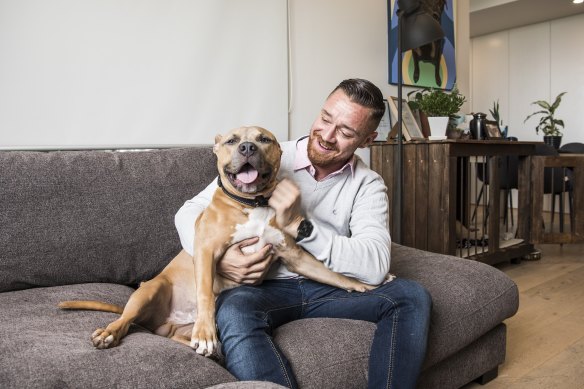This was published 2 years ago
‘Unique on a global scale’: NSW nears elimination of HIV as cases fall to record lows
By Lucy Carroll and Mary Ward
NSW reported its lowest number of new HIV infections on record last year with the goal of elimination of the virus in the state now “well within reach by 2025”.
The achievement would make NSW one of the first places in the world to eliminate HIV before the global target of 2030, public health experts say.

Ruan Uys was diagnosed with HIV in 2016 and says stigma is the biggest barrier to ending the disease.Credit: Steven Siewert
Broad uptake of preventive treatments and less casual sex during the pandemic were viewed as reasons for the fall in infections in 2021.
Data released by NSW Health shows the state recorded a total of 178 new HIV infections last year, a 36 per cent drop compared to the average over the past five years.
“What we are seeing in NSW is unique on a global scale,” Professor Andrew Grulich, head HIV Epidemiology and Prevention Program at the UNSW Kirby Institute, said. “The world is watching what NSW is doing. The decline is definitely real, but it has been accelerated by COVID-19 restrictions.”
Grulich said the steep decline in infections during the pandemic was in part due to “reduced risk-taking behaviour, a dip in testing and lower levels of sexual activity”, but noted the fall was against a backdrop of a steady decline over the previous decade.
“Provided there is a strong uptake in PrEP as people emerge from their post-pandemic bunkers we really do have the potential to drive HIV towards elimination. It is critical that those people who have fallen out of regular HIV testing during the pandemic get back to that.”
He said while the global goal to end HIV infections by 2030 “has been viewed by many as unrealistic, NSW can provide the data that shows it can be done. It is now definitely within reach by 2025”.
NSW’s latest HIV Strategy report shows testing for HIV was 12 per cent lower last year than during 2019, but rates increased in the last quarter of the year as the state exited lockdown.
There were 541,800 HIV serology tests in the state in 2021, similar to the 547,287 recorded in 2020.
Testing in public sexual health clinics has been significantly down since mid-2020. Although an increase was seen in the October-to-December quarter, it only constituted 58 per cent of tests during the same period in 2019.
A similar pattern was seen among people starting PrEP, with a 61 per cent increase in people starting treatment in October to December last year, compared to the previous quarter, but fewer people starting the preventative medication than in the pre-COVID world.
Almost a third of the 178 new diagnoses last year were in those who likely contracted the virus recently, or within the preceding 12 months.
HIV diagnoses in NSW have gradually tracked down from 2015 to 2019, dropping by about 20 per cent overall and by 25 per cent among men who have sex with men.
The aim of the HIV Strategy 2021-2025 is the virtual elimination of transmission by reducing preventable infections by 90 per cent, starting people on treatment soon after diagnosis and reducing stigma and discrimination as a barrier to prevention and treatment.
But Grulich noted that in a number of groups in NSW “we are not seeing declines of the same magnitude as those in Australian-born gay men and those living in cities”.
“We do need to focus driving infections down in young men born overseas and people living in outer Sydney suburban and regional NSW,” he said.
Head of NSW Health’s STI Programs Unit, Dr Christopher Bourne, said while testing fell away during 2021 the numbers “were still pretty good. In other countries, the drops have been way more dramatic”.
“What we’re seeing is essentially the extension of the downward trend. Men who are HIV negative are still accessing PrEP and testing rates are now moving back to where they should be. The important thing is that fewer infections are newly acquired.”
Ruan Uys, who was diagnosed with HIV in 2016, said despite the initial shame and stigma when he was diagnosed, ultimately it was peer connection that saved his life.
He now works in advocacy at the Bobby Goldsmith Foundation in Sydney, after founding the “Hivsters” online support group.
“We have the tools, we have the science, to end HIV. What we need to do is educate and reduce stigma around it,” he said.
While significant strides have been made with promoting messages including the benefits of PrEP among men who have sex with men, Uys said this information needed to spread to the infection’s new frontier.
“HIV is fast becoming a heterosexually acquired infection,” he said. “It’s important for hetero and bi people to get tested. Migrants, the international student community – those communities really need to know we have the support here for them.”
Uys said while he was “super privileged” to live in a time where HIV can be treated with a daily pill, it was important the public also knew about the other treatments available.
Earlier this month, Cabenuva, Australia’s first long-acting HIV treatment was added to the PBS. The injection, given every two months, is an alternative to a daily pill.
“That is going to be magic for people who have transient lifestyles and also for people in certain cultural communities where the daily pill can be a form of disclosure,” he said.
The Morning Edition newsletter is our guide to the day’s most important and interesting stories, analysis and insights. Sign up here.